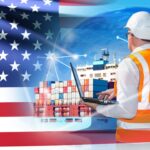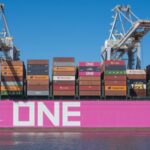The White House confirmed a one-year suspension of US port fees and other measures imposed under a Section 301 investigation targeting China’s dominance in the global shipbuilding, logistics and maritime sectors. The move, which takes effect on November 10, 2025, represents a significant de-escalation in trade tensions that have destabilized global shipping markets throughout the year.
Read also: Zeneta: US-China truce offers relief, but container prices are expected to fall further in 2026
The suspension was announced as part of a broader trade agreement between President Donald Trump and President Xi Jinping last week in Busan, South Korea, and covers all “responsive actions” associated with the Section 301 investigation, while the two sides negotiate a long-term maritime framework.
“The United States will suspend for one year implementation of Section 301 actions regarding China’s targeting of the maritime, logistics, and shipbuilding sectors for dominance,” the White House said in its fact sheet. “During this time, the United States will continue negotiations with China while deepening cooperation with Korea and Japan to revitalize American shipbuilding.”
Reciprocal steps from China
In return, China will roll back its retaliatory measures, including sanctions on several shipping entities – believed to include units of Korean shipbuilder Hanwha – and the suspension of counter-tariffs on ships linked to the United States for one year.
The origin of the port fee goes back to a Section 301 petition filed in March 2024 by the United Steelworkers (USW) and a coalition of labor unions. The petition accused Beijing of using government subsidies and non-market practices to control the global ship industry. Following that complaint, the US Trade Representative (USTR) ruled in January 2025 that China’s maritime and shipbuilding policies were “unreasonable” under US trade law.
“Today, the United States ranks 19th globally in commercial shipbuilding, producing fewer than five ships per year, while China is building more than 1,700,” said Katherine Tai, a former US Trade Representative under the Biden administration. “China’s dominance in this sector undermines fair competition and remains the biggest obstacle to reviving American shipbuilding.”
The commentary covers extensive naval actions
The White House said the suspension applies not only to port fees on China-linked ships — introduced on October 14 — but also to potential tariffs on Chinese-made cranes and cargo-handling equipment, duties on foreign-made motor carriers, and rules associated with LNG shipping incentives.
While the move alleviates immediate financial pressures on shipping operators, it also raises questions about the future direction of US industrial maritime policy.
The industry is divided on impact
Labor Party representatives expressed mixed reactions. Roy Houseman, legislative director for United Steelworkers, called the suspension a “truce with loose ends,” warning that Washington still lacks a cohesive plan to rebuild domestic shipyard capacity.
“53% of all global ship orders by tonnage in the first eight months of 2025 went to China,” Hausmann said. “This level of focus is unhealthy. We need policies that truly revitalize shipbuilding in the United States.”
However, shipping industry groups widely welcomed the decision. The International Chamber of Shipping (ICS) described the suspension as a “positive step towards stability,” noting that the previous tariff regime “already posed significant challenges and disruptions” to global trade.
World Shipping Council President Joe Kramick echoed these sentiments:
“Global trade flows best when it flows freely. The suspension of ship tariffs by both the United States and China is a win for exporters, importers and consumers alike.”
Next Steps: Regulatory details are still pending
Despite the White House’s confirmation, maritime law experts cautioned that the details still hinge on upcoming regulatory filings.
“The administration’s fact sheet sets out the timeline, but the formal regulatory language will determine the true scope of the suspension,” said Brian Maloney, a partner at Seward & Kessel’s maritime and transportation group. “USTR’s public comment period on the Section 301 investigation ends on November 10, so final regulatory action will likely follow soon after.”
For now, the temporary suspension offers a welcome reprieve for shipping companies caught between opposing trade measures — but with only a one-year window, industry watchers say the truce may simply postpone deeper political fights over how to rebuild American shipbuilding competitiveness in the face of China’s global maritime dominance.










